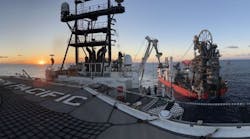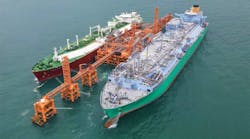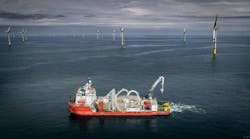Useful tools for route planning at sea and optimizing ship perfor-mance and safety are available from Seaware. The company has a suite of three programs, the last of which it expects to launch in the summer.
The two systems already available are:
- Seaware Routing, which provides graphical weather presentation and route planning, including predicted ship performance in terms of speed, fuel consumption, and estimated time of arrival (ETA)
- Seaware EnRoute Live, which in addition to the features of Seaware Routing provides on-line support at sea with continuous evaluation of the sea-state and wave-induced effects on the ship, gives warnings when the vessel's performance limits are being exceeded, and includes both maneuvering advice functionality and a post-voyage functionality.
The product currently under development is Seaware Routing Plus, an enhanced version of Seaware Routing that provides predictions of the ship's dynamics along the route.
Most of the Seaware staff have a background in research activities based on advanced seakeeping theories at the Royal Institute of Technology in Stockholm, in addition to software development expertise. The company is partnered by SMHI WeatherRouting, which provides the meteorological input.
The products are of interest to the offshore market, according to Henrik Rinder, one of the company's founders. Obvious applications are transportation vessels carrying offshore modules, platforms or drilling rigs, and vessels serving offshore fields, such as supply boats and shuttle tankers. Pipe and cable-layers and lift-vessels, for which weather and sea-state are critical parameters, would also benefit. Rinder sees further potential in adapting the products for use with floating platforms.
The products are designed to provide decision support systems for seakeeping and optimizing ship performance. Particulars of the ship are entered into the system – basic information such as design, dimensions, and propulsion – while variable information such as the vessel's loading condition is entered ahead of each voyage. Taking into account the weather forecast, the system can predict the ship's performance along the route, calculating factors such as fuel consumption, speed, and ETA. The performance predicted for different possible routes can be compared and the most favorable option selected.
The system is run on a PC with a GPS connection and an email connection to SMHI, from which weather forecasts are requested and received. SMHI can also provide personal contact with a marine meteorologist, routing support and comments on the reliability of the weather forecast. The connection can also serve to send daily ship-to-land reports, and the vessel's progress can be tracked by SMHI using its FleetWeb system.
These basic features are available in Seaware Routing. Seaware Routing Plus has the additional capability of predicting the ship's dynamics along the route. These are evaluated in terms of:
- ship's motions, bow slamming, and green water on deck
- accelerations
- effective heel
- vertical bending moment
- dynamic stability according to IMO MSC/Circ 707.
By comparing predicted sea conditions with the ship's seakeeping abilities, this product makes it possible to identify states in which cargo damage could be suffered or which could be hazardous for the ship, thus making an important contribution to safety of vessel, crew, and cargo.
Despite the accuracy of modern weather forecasting techniques, variations are always likely between the forecast and actual conditions, especially when forecasting for more than a few hours ahead – the reality can develop differently from the forecast in terms of timing and the strength and direction of weather trends.
null
Real-time assessment
Seaware EnRoute Live takes this fact into account by adding a real-time risk assessment functionality, allowing critical situations at sea to be detected and managed. Its risk analysis capability includes the automatic and continuous measuring of the actual sea-state in which the ship is traveling, and continuous calculation of wave-induced seakeeping effects. Based on this data it provides predictions of the worst-case scenario that can arise in the course of the coming hour, and gives warning when the defined limits for wave-induced seakeeping effects are exceeded. It also provides advice on maneuvering in potentially hazardous conditions.
Real-time information on the ship's performance and sea-state is provided by means of a motion sensor installed near the vessel's center of gravity, which uses the ship as a wave buoy. The sensor is also able to monitor key selected positions elsewhere on the ship. The data is fed into a program that draws on advanced linear and non-linear hydrodynamic procedures and a full data model of the geometrical and mechanical properties of the ship to calculate the ship's dynamics.
The system keeps a complete record of data and events during a voyage. The record can be used for analysis, for example, to examine under what conditions damage was sustained by the cargo or the ship itself, or to build up a database with a full record of the ship's dynamic history and performance.
Features not available in competing systems include the use of actual calculations instead of empirical characteristics to predict a ship's performance in Seaware Routing; route planning taking into acc-ount wave-induced effects and dynamic stability; route optimization with respect to wave-induced effects in Seaware Routing Plus; and automatic sea-state evaluation, maneuvering advice, and dynamic stability warnings in Seaware EnRoute Plus.
For more information contact Anders Olander, Seaware. Tel: +46 8715 4713, fax: +46 8556 606 05. [email protected], www.seaware.se






